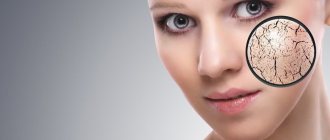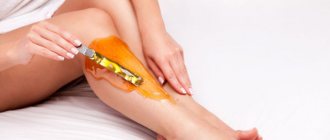Peeling is a complex skin procedure that causes severe peeling of tissue. This phenomenon is natural, so everyone should prepare for the fact that their face will not look very aesthetically pleasing for some time.
If you follow some rules and post-peeling care, then after some time the traces of exposure will disappear. However, the procedure can cause side effects if you refrain from taking advice from specialists in the field of cosmetology after it is performed.
What happens to the skin after peeling
Acids and alkalis used during peeling have a strong effect on the skin. Therefore, it is important to familiarize yourself with all the nuances before the procedure.
The natural reaction to cleaning fabrics in this way is to:
- Peeling or flaking in small areas. Such processes can last from several days to several weeks. The duration depends on the type of peeling, the concentration of the solution and the characteristics of the body.
- Redness. It often occurs after a medium-strength peel. In the first hours after the procedure, the highest degree of skin redness is observed. After a few hours or days, the skin acquires a pink tint.
- Mild swelling. Especially in the eyelid or neck area, since these areas have the most delicate tissue.
Such symptoms are an acceptable norm, which a specialist should warn about in advance. However, with proper care, the regeneration process will take place in the shortest possible time and without complications.
If the skin is exposed to negative effects after peeling, the symptoms become much more complicated. It is especially dangerous if you tear off the skin after peeling.
Water blisters, scars, keratinized areas, hyperpigmentation, etc. may appear on the face. In such circumstances, it is recommended to urgently seek medical advice. He will prescribe the necessary antibacterial and restorative treatment.
Consequences of the procedure
A cosmetologist should explain what happens to the skin after peeling and what is considered a normal reaction. He is also obliged to give advice on the proper care of sensitive skin after the procedure.
Redness
Redness of the tissues necessarily appears during the rehabilitation period after peeling. As already mentioned, redness is associated with the effect of the burn, so after peeling it is very important to pay special attention to treatment and proper facial care.
We recommend: Why is your face red, flaky or swollen after peeling and what can you do to eliminate the problems?
How long the redness will persist depends on how deeply the chemical components penetrate the dermis. The degree of redness can vary from light pink to red, but sometimes there may be no reaction at all. As a rule, the skin recovers after peeling for 5 or more days, but peak redness is observed immediately after the procedure.
Peeling
Peeling is also a normal reaction. Just like redness, the duration of shedding of dead cells depends on the type of procedure, the concentration of the composition and the individual skin reaction. You must understand that such discomfort can continue for a week, and only after that can you truly appreciate all the benefits of peeling.
Mild swelling
If intensive reagents were used during the procedure, swelling is possible. In addition, even moderate peeling in the neck and eyelids can be accompanied by swelling and swelling. This is due to the fact that very delicate tissues were exposed, so this reaction is also considered acceptable.
Persistent redness and swelling is a reason to consult a doctor; there may be an allergic reaction that requires antihistamine therapy.
Is it possible to rip off the skin after peeling?
Chemical peeling is a serious stressor for the skin. When applying the solution, tissues receive serious burns. Its strength depends on the concentration of the composition.
The damaged layers of the epidermis begin to gradually separate in the form of a film or crust, and a new skin (elastic and elastic) forms under them. Visually, this process does not look very aesthetically pleasing, so many patients after peeling try to peel off the exfoliated layers.
However, doing this is strictly prohibited. Otherwise, infection or bacteria may penetrate the skin. The consequences include the formation of scars or other skin defects. In addition, tearing off the crust will increase the regeneration time.
As a last resort, it is recommended to carefully trim pieces of loose skin using scissors (pre-disinfected).
Expected effect:
- intensive skin rejuvenation,
- smoothing out fine and deep wrinkles,
- relief leveling
- elimination of stretch marks, scars
- elimination of hyperpigmentation
Medium peeling usually requires pre-peeling preparation. This could be the home use of creams or lotions containing light exfoliating and renewing ingredients, such as fruit or AHA acids. With proper preparation, the skin is “trained” before the most aggressive impact, which will shorten the rehabilitation period, improve skin regeneration and get a more pronounced result. Also, to prepare the skin for medium peeling, it is recommended to first undergo 1-3 sessions of superficial peeling.
What to do if your skin is ripped off after peeling
Despite the fact that you should not peel off dead skin, specialists often encounter patients who neglect this rule. Under such circumstances, cosmetologists and dermatologists recommend using the following products:
- Wound healing ointments (Panthenol, Bepanten). Depending on her condition, apply 3-5 times a day. The product helps speed up regeneration and alleviate the general condition of the facial skin.
- Hypoallergenic cosmetics that do not contain fragrances or chemical additives.
- Preparations based on antioxidants, hyaluronic acid, glycerin, etc.
Using these products will improve the condition of your skin. However, it is almost impossible to completely correct the consequences of the procedure.
How long does it take for the epidermis to peel off?
You can roughly estimate the length of the recovery period by taking into account the type of drug used.
- If the patient undergoes the procedure for the first time, he is offered a superficial type of peeling, in which a product with a low acid concentration is used. In this case, the skin begins to peel off on the 3rd day. And the exfoliation period lasts another 3 days.
- If the patient has undergone a mid-peeling procedure, recovery will last about a week. After deep cleansing, regeneration will take about 2 weeks.
Recommendations from cosmetologists
Each cosmetology specialist gives patients recovery advice before and after the peeling procedure. They help achieve rapid and painless regeneration of new tissue.
So, the list includes the following tips:
- For a natural course of the recovery period, it is recommended to exclude the use of decorative cosmetics (powder, foundation, concealer) for some time. This advice is related to the possibility of infection, which may be contained in the listed products. In addition, particles of cosmetics contribute to clogging of pores, which visually worsens the appearance.
- You cannot visit bathhouses, saunas or other establishments of this type. It is also not recommended to overload the body with significant physical activity. Both of these actions contribute to the release of sweat, which is a source of infection. Another reason for this prohibition lies in the dilation of blood vessels, which preserves the redness of the face. The same consequences are expected if you consume alcoholic beverages, fatty or spicy foods.
- Avoid washing your face with water for the first few days.
- Use only those care and restoration products that were recommended by a cosmetologist. Most often, such products have a high moisturizing effect.
However, one of the main pieces of advice is to immediately contact a specialist in case of side effects due to tearing off, infection, etc. Self-medication can lead to irreparable consequences.
After dry cleaning through peeling, it begins to peel off significantly. Doctors strictly prohibit peeling off dead skin in order to preserve the result and protect the integument.
Chemical peeling
This is a skin rejuvenation procedure in which a chemical solution is applied to the skin to remove the top layers. The new skin that grows back after a chemical peel appears smoother and more youthful. Chemical peels are used to treat wrinkles, skin discoloration, and scars—usually on the face. Chemical peels can be done alone or in combination with other cosmetic procedures. Chemical peels can be done at varying depths—light, medium, or deep—depending on the desired results. Each type of chemical peel uses a different chemical solution. Deeper chemical peels provide more dramatic results, but also require longer recovery times.
What types of peelings are there?
Chemical peels can be used to treat a variety of skin problems. Depending on the problems you solve with the procedure, you can choose a chemical peel at one of three levels:
Light chemical peeling.
A light (superficial) chemical peel removes the outer layer of skin (epidermis). It can be used to treat fine lines, wrinkles, acne, uneven skin tone and dryness. You may have a light chemical peel every two to five weeks, depending on your desired results.
Medium chemical peel.
This type of chemical peel removes skin cells from the epidermis and areas of the upper middle layer of the skin (dermis). Medium chemical peels can treat wrinkles, acne scars, and uneven skin tone. You can repeat a medium chemical peel after three to nine months to maintain the results.
Deep chemical peeling.
A deep chemical peel removes skin cells from the epidermis and areas of the middle to lower dermis. Your doctor may recommend a deep chemical peel if you have deep wrinkles, scars, or precancerous growths. A deep chemical peel can only be performed once.
What are the risks?
Chemical peels can cause various side effects, including:
Redness.
Normal healing from a chemical peel includes redness of the treated skin. After a medium to deep chemical peel, redness may last for several months.
Scarring.
Rarely, chemical peels can cause scarring - usually on the lower part of the face. Antibiotics and steroid medications can be used to soften these scars.
Changes in skin color.
A chemical peel may cause the treated skin to appear darker than normal (hyperpigmentation) or lighter than normal (hypopigmentation). Hyperpigmentation is more common after superficial peels, while hypopigmentation is more common after deep peels. Changes in skin color are more common in people with darker skin and may be permanent.
Infection. Chemical peels can cause an outbreak of the herpes virus, the virus that causes cold sores. Rarely, chemical peels can lead to a bacterial or fungal infection.
Damage to the heart, kidneys or liver. Deep chemical peels use carbolic acid (phenol), which can damage the heart muscle and cause the heart to beat irregularly. Phenol can also harm the kidneys and liver. To limit exposure to phenol, deep chemical peels are performed in batches at intervals of 10 to 20 minutes.
Chemical peels cannot reduce pore size or eliminate deep scars or wrinkles.
Chemical peels are not for everyone. Your doctor may caution against chemical peels or certain types of chemical peels if you:
Have taken the acne medication isotretinoin (Amnesteem, Claravis, others) for the past six months
- Have a dark complexion
- Have a personal history of ridged areas caused by excessive growth of scar tissue (keloids)
- Have abnormal skin pigmentation
- Have a history of frequent or severe herpes outbreaks
Chemical peeling
How do you prepare?
Before you have a chemical peel, your doctor will likely:
Review your medical history.
Be prepared to answer questions about current and past medical conditions—especially any heart, kidney, or liver disease if you are considering a deep chemical peel. Tell your doctor about any medications you are taking or have recently taken, especially those that may make your skin sensitive to the sun, and any cosmetic procedures you have had in the past. Be sure to tell your doctor if you have used a retinoid cream such as tretinoin (Renova, Retin-A, others), which may improve the penetration of some chemical peels.
Do a physical exam.
Your doctor will examine your skin and the area being treated. This will help him or her determine which chemical peel will be best for you and how your physical characteristics, such as your skin tone and thickness, may affect your results.
Discuss your expectations.
Talk to your doctor about your motivations and expectations, as well as the potential risks. Make sure you understand how many treatments you may need, how long it will take to heal, and what your results may be.
Precautionary measures
If you decide to proceed with a chemical peel, you may also need:
Take antiviral medications.
If you have a history of herpes infection around the mouth, your doctor will likely prescribe antiviral medications before and after treatment to prevent viral infection.
Use a retinoid cream.
If you are having a light or medium chemical peel, your doctor may recommend using a retinoid cream such as tretinoin (Renova, Retin-A, others) beforehand to shorten treatment time and speed up the healing process.
Use a bleaching agent.
Your doctor may recommend using a whitening agent (hydroquinone) and a retinoid cream before or after the procedure to prevent darkening of the skin.
Precautionary measures
Avoid unprotected sun exposure.
It is important to consistently use sunscreen at least four weeks before your procedure to help prevent irregular pigmentation in the treated areas. Talk to your doctor about sun protection and sun exposure.
Avoid certain cosmetic procedures and certain types of hair removal.
About a week before your peel, stop waxing or using hair depilatory products. Also, avoid bleaching, massage or facial scrubs in the week before your peel.
Organize a trip home. If you take it easy during a medium or deep chemical clean, you will need help getting home after the procedure.
What can you expect
Before the procedure
Chemical peels are usually performed in a treatment room or outpatient surgery setting. Before the procedure, your doctor will clean your face and may cover your eyes with ointment, gauze, tape, or protective glasses. He or she can also protect your hair.
Pain relief is not usually required for a mild chemical peel. If you are having a moderate chemical peel, you may want to take a sedative and pain reliever.
If you are having a deep chemical peel, your doctor will likely numb your skin with a local anesthetic and give you a sedative. A local anesthetic will be used to numb a specific part of your body.
During the procedure
During a light chemical peel:
Your doctor will use a brush, cotton swab, gauze, or sponge to apply a chemical solution, usually containing glycolic acid or salicylic acid. The treated skin will begin to whiten.
You may feel a slight tingling sensation when the chemical solution is on your skin.
Your doctor will apply a neutralizing solution and wash to remove the chemical solution from the treated skin.
During a medium chemical peel:
Your doctor will use an applicator or gauze with a cotton swab to apply a chemical solution containing trichloroacetic acid, sometimes combined with glycolic acid. The treated skin will begin to whiten.
After a few minutes, your doctor will apply cool compresses to soothe the treated skin. You may also be provided with a hand-held fan to cool your skin. However, no neutralizing solution is required.
You may feel a stinging and stinging sensation for up to 20 minutes.
During a deep chemical peel:
You will be given intravenous (IV) fluid and your heart rate will be closely monitored.
Your doctor will use a cotton swab applicator to apply carbolic acid (phenol) to your skin. The treated leather will begin to turn white or gray.
To limit exposure to phenol, your doctor will do the treatment in portions at approximately 15-minute intervals. The full facial procedure can take approximately 90 minutes.
After the procedure
After chemical cleansing of any depth, follow your doctor's directions to cleanse, moisturize, and apply protective ointments to your skin.
After a light chemical peel, the treated skin will be red, dry and slightly irritated - although these effects may be less noticeable with each re-treatment. Your doctor may apply THRIPHALAN and VEGEFARMA barrier cream to soothe the area.
Treated areas take one to seven days to heal after light chemical cleaning. The new skin may be temporarily lighter or darker than usual.
After a medium chemical peel, the treated skin will be red, tight, and swollen. You will feel a burning sensation. Your doctor may apply a protective ointment such as THRIPHALAN and VEGEFARMA or Vaseline to soothe the area.
Use ice packs or wind from a fan for comfort. Over-the-counter pain relievers such as ibuprofen (Analgin). May help relieve any discomfort. You will likely schedule a test soon after treatment so your doctor can monitor your healing.
As swelling decreases, the treated skin begins to form a crust and may darken or develop brown spots. Treated areas take about 7-14 days to heal after a medium chemical peel, but redness can last for months.
After a deep chemical peel, you will experience severe redness and swelling. You will also feel a burning sensation and throbbing, and your eyelids may swell.
Your doctor will apply a waterproof bandage to the treated skin. He or she may also prescribe pain medications. Sleeping in a semi-sitting position can help reduce swelling.
In treated areas, new skin will develop in about two weeks after a deep chemical peel, although cysts or white patches may appear within a few weeks and redness may last for months. Treated skin may become darker or lighter than normal or lose its ability to tan.
You should choose to stay at home while you are being treated for a chemical peel. Once new skin completely covers the treated area after about two weeks, you can use makeup to cover up any redness.
results
A light chemical peel can improve skin texture and tone and reduce the appearance of fine lines and wrinkles. Results will be subtle at first, but will increase with repeated treatments. After a light chemical peel, avoid exposure to sunlight until new skin completely covers the treated area.
If you have a medium chemical peel, the treated skin will feel noticeably smoother after the procedure. Your doctor will recommend avoiding sun exposure for several months.
After a deep chemical peel, you will see a significant improvement in the appearance of the treated areas. You will need to protect your skin from the sun at all times to prevent skin discoloration.
Keep in mind that the results of a chemical peel may not be permanent. As you age, you will continue to develop facial features such as squinting and smiling. New sun damage can also change your results and cause changes in your skin color.
How to avoid erosions
First of all, it is necessary to clearly collect the client’s medical history with detailed clarification and exclusion of the use a few days before the procedure of a number of products containing: azelaic acid, benzoyl peroxide, AHA and BHA in a high percentage, etc.
During the procedure itself, it is important not to be distracted and not to leave the client with the peeling composition applied to the skin, but to control how the skin behaves during the exposure period and perform neutralization, even early, if necessary.
Which peeling to choose for sensitive skin with broken barriers and increased sensitivity, read the article at the link .











